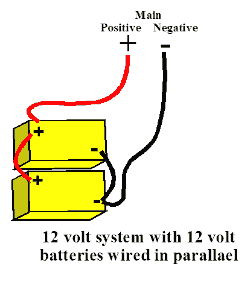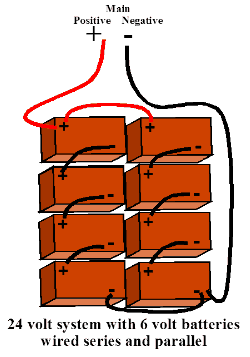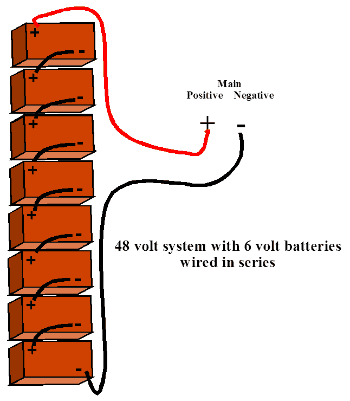|
BASIC BATTERY WIRING: how to connect batteries in series and parallel
to get the right system voltage and amperage capacity.
A battery bank is a group of batteries wired together using series
and/or parallel wiring.
A series connection is made by connecting one pair of opposite terminals
of different batteries together (i.e. positive to negative). This increases
the total voltage (the voltages of the two or more batteries are simply
added together), while keeping the amperage capacity the same as just one
of the batteries that are wired in series. Chances are you've been making
series connections all your life -- flashlight batteries are put end to
end, nose (+) to butt (-).
The diagram at lower right, below, shows 8 batteries connected together
in series. This is one "string." Since these are 6V batteries,
the nominal voltage of this string is 48V. If each battery is rated at 250AH,
the AH capacity of the entire string is still just 250AH, since voltages,
not amperages, add together in series wiring.
A parallel connection is made by connecting like terminals of two
or more batteries together (i.e. positive to positive and negative to negative).
This increases the amperage of the circuit (the AH capacities of the batteries,
or strings of batteries, are simply added together) while keeping the total
voltage the same as one of the batteries, or paralleled strings of batteries,
in that bank.
The diagram at upper left shows two 12V batteries
that are paralleled together. The total voltage of this battery bank is
12V. If each battery is rated at 250AH, the AH capacity of the battery bank
is 500AH, since amperages, not voltages, add together in parallel wiring.
Often battery banks are connected together using both series and parallel
wiring, as in the diagram at lower left, below. It shows eight batteries
wired into two series strings of four batteries each. If they are 6V batteries
of 250AH each, then each string has a voltage of 24V (6V x 4) and 250AH.
The two series strings are then wired in parallel, which doubles the amperage
capacity to 500AH, without changing the voltage.
| Here, two 12V batteries
are paralleled for the same voltage but double the amperage. |
Here, 6V batteries are wired two in series for 12 volts,
then paralleled for more amperage. |
 |
 |
| Below, the voltage is
increased by adding multiple batteries in series, with two strings
in parallel for twice the amperage. |
Below, voltage is increased to 48 v by connecting eight
6 v batteries in series (8 x 6v = 48v ). |
 |
 |
IMPORTANT: In parallel systems, always pull your main cables from
opposite corners of the battery bank! (as in the above drawings)This way
all the batteries are charged and discharged equally. Disappointing performance
and premature battery failure await those that don't heed this simple
rule.
Many other configurations are possible using the same series and parallel
methods. We don't recommend more than 4 parallel sets of batteries in
any configuration. Batteries can be series connected to very high voltages,
some electric vehicles are wired for over 300 volts! For solar you need
to match the batteries to your inverter and charge controller, which are
almost always 12, 24, or 48 volts. Solar modules are wired similarly in
series to get the correct voltage and paralleled to add current.
The batteries can also be oriented in different directions to fit tight
spaces, but you may need longer jumpers. They can even be stacked on shelves,
but leave enough room between shelves to add water to the batteries. Finally,
make sure the battery jumper cables don't obstruct the watering caps.
We sell cables that are just the right length for the job, too long and
they'll get in the way, too short and..... you're not making the connection.
|